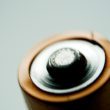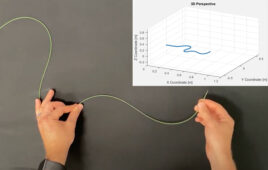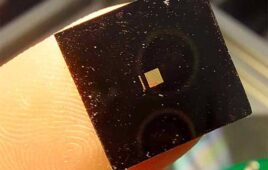
The photograph on the left shows a sample with four metal contacts. On the right is an illustration of a laser drawing a conductive path between two contacts. [Washington State University]
“Electrical conductivity affects how cells adhere to a substrate. By optically defining highly conductive regions on the crystal, cells could be manipulated and perhaps used in bioelectronic devices,” Matt McCluskey, a Washington State University professor of physics and materials science, told MDO.
The work of McCluskey and colleagues could open the door for transparent, three-dimensional electronics that can even be erased and reconfigured as though the crystal were an Etch A Sketch.
The research has its roots four years ago, when a WSU doctoral student accidentally discovered that crystal strontium titanate’s electrical conductivity increased 400-fold through light exposure. In their latest experiments, the research team used a laser to etch a line in the crystal and then carried an electrical current through it. And they’ve now increased the crystal’s conductivity 1,000-fold – with the phenomenon lasting up to a year.
“It opens up a new type of electronics where you can define a circuit optically and then erase it and define a new one,” McCluskey said in a news release.
“We look at samples that we exposed to light a year ago and they’re still conducting,” McCluskey said. “It may not retain 100 percent of its conductivity, but it’s pretty big.”
Because the crystal strontium titanate’s “persistent photoconductivity” phenomenon occurs at room temperature, it’s also an easier material to improve when it comes to conductivity versus, say, cooling materials with liquid nitrogen.
“We’re still trying to figure out exactly what happens,” McCluskey said. His educated guess is that heat pushes strontium atoms out of the crystal strontium titanate. The resulting light-sensitive defects lead to persistent photoconductivity.
McClusky and his colleagues are able to erase etched circuits by heating the crystal on a hot plate. They then recast new circuits using an optical pen.
“It’s an Etch A Sketch,” McCluskey said. “We’ve done it a few cycles. Another engineering challenge would be to do that thousands of times.”
The National Science Foundation funded the research. Co-authors included former students Violet Poole and Slade Jokela.
[Want to stay more on top of MDO content? Subscribe to our weekly e-newsletter.]







